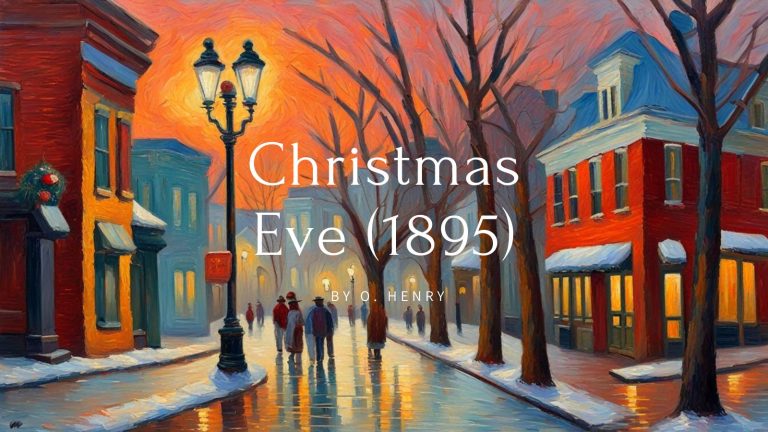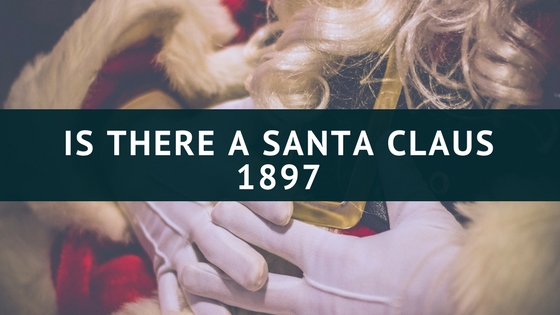The Day After Christmas
by Joyce Kilmer
OF course, people still ride on the elevated railways. But not the people who used to be taken over by their mothers from Jersey City on the Cortlandt Street Ferry about once every month, and then up Sixth Avenue by the elevated en route for the shops. These people now know the swift and monotonous tube train instead of the rakish ferryboat, the dull subway instead of the stimulating elevated railway. And even if they knelt upon the seats of the subway car, their rubbers projecting into the aisles and their faces pressed against the windows, they would see only blank walls and dismal stations instead of other people’s Christmas trees.
These evanescent bits of glory lent special delight to aërial journeyings for weeks after Christmas. For, in defiance of the Twelfth Night convention, certain citizens were wont to keep their Christmas trees in place until February. And, in the opinion of the tenants of the third stories of the tenements (apartment houses is the more courteous word) which bordered the elevated, the place of the Christmas tree was close up against the front window, where all the world could enjoy its green and gold and red.
Like nearly all genuine vulgar customs (vulgar is used in its most honorable sense) this habit of showing the public the home’s chief splendor was (or is, for undoubtedly firs dressed for holiday still brighten some lower Sixth Avenue windows) based on generous courtesy. It was not possible for Mr. Tenement to keep open flat, so to speak, at Christmas time; to summon all Sixth Avenue in to partake of a bowl of wassail that steamed upon his gas range. But he performed all the hospitality that his ungentle residence allowed; he placed his bit of greenwood with its cardboard angel, its red paper bells, and its strings of tinsel, where it would give to the greatest possible number the same delight that it gave to its owner.
It is, you observe, in your own psychological way, the Rogers Group principle. Your grandmother put “Going for the Cows,” you remember, on the marble top of the walnut table by the window in the front parlor. The Nottingham lace curtains were parted just above the head of the boy who was urging the dog after the woodchuck.
And everybody who went up or down Maple Avenue got a good view of that masterpiece of realism. Therein your grandmother showed truer courtesy than did you when you put Rodin’s “Le Baiser” in that niche above the second landing of your stairway.
The same quality of almost quixotic generosity is suggested by the composition of the old-fashioned holly wreaths, which, hung in the windows, showed to passers-by lustrous green leaves and scarlet berries, and to those who hung them only a circle of pale stems and wire. Even the lithographers maintain this courteous tradition; they stamp their cardboard holly wreaths on only one side. And this is the side which is to face the street.
Well, these fenestral firs and hollies exist, and they are among the numerous joys of the days that follow Christmas. These post-Christmas days shine with a light softer, but perhaps more comfortable, than that of the great feast itself.
Particularly is this true of the first day after Christmas—especially when that day is Sunday. In England, of course, as in the time of the late Samuel Pickwick, Esq., who brought about the renascence of Christmas, this is called Boxing Day, not because it is the occasion of fistic encounters, but because it is the time appointed for the distribution of those more or less spontaneous expressions of good will which are called Christmas boxes. Its more orthodox title is Saint Stephen’s Day; it is, you know, the day on which the illustrious King Wenceslaus, with the assistance of his page, did his noble almoning. Says the old carol:
| Good King Wenceslaus looked out
On the feast of Stephen, When the snow lay round about, Deep, and crisp, and even; Brightly shone the moon that night, Though the frost was cruel; When a poor man came in sight, Gathering winter fuel. “Hither, page, and stand by me, See thou dost it telling Yonder peasant, who is he, Where and what his dwelling?” “Sire, he lives a good league hence, Underneath the mountain, Over by the forest fence, By Saint Agnes fountain.” “Bring me flesh and bring me wine, Bring me pine logs hither; Thou and I will see him dine, When we bear them thither.” Page and monarch forth they went, Forth they went together Through the night wind’s wild lament And the wintry weather. |
We are not old English Kings, so instead of having our page bring flesh and wine to the poor man on Saint Stephen’s Day, we give a dollar to the youth from the still vexed Bermuthes who chaperons the elevator in our apartment house, and for weeks before Christmas we affix to the flaps of the envelopes containing our letters little stamps bearing libelous caricatures of Saint Nicholas of Bari. Theoretically this last process provides a modicum of Christmas cheer for certain carefully selected and organized poor people.
However this may be, the fact remains that the day after Christmas is a very good day, indeed. The excitement of giving and receiving has passed away; there remains the quieter joy of contemplation. And since this year the day after Christmas is Sunday, this contemplation will not be disturbed by the arrival of the postman, who, a relentless bill-bringer, is, like the Greeks, to be feared even when bearing gifts.
And, in spite of the remarks of every humorist who ever borrowed from his mother-in-law two cents to put on an envelope which should carry a joke about her to an editor, this post-Christmas meditation nearly always is pleasant. It is assisted by the consumption of wife-bestowed cigars, which (again despite the humorists!) are better than those a man buys for himself. It is a pleasant meditation, for its subjects are things given and things received, good deeds done and good deeds experienced.
It also contains, this day-after-Christmas feeling, a quality of reconciliation. Not of reconciliation with ancient enemies—this was all orthodoxly attended to on Christmas Eve—but of reconciliation with affairs, of readjustment.
On Christmas Day there may have been some slight disappointment, some fly in the ointment, or, worse still, in the punch. Forgetting for a moment that you were just now pictured smoking cigars presented to you by your wife, let us consider you to be, as you probably are, a young woman of some eighteen Summers and perhaps an equal number of Winters. It is the day after Christmas; it is (although you are unaware of the fact) Saint Stephen’s Day. Yesterday, although you endeavored to conceal the fact, only revealing it in the unnecessary viciousness with which you scrubbed the remains of a red and white striped candy basket from the countenance of your infant brother—yesterday, I repeat, you were annoyed. And the cause of your annoyance was that you received from the amorous Theophilus a paltry dozen, instead of twenty-four or thirty-six, American Beauties. Now, however, during your post-Christmas meditation, your annoyance is swept away by the refreshing thought that Theophilus will now have twelve or twenty-four dollars more to invest in that extraordinary solitaire diamond ring with which he purposes to decorate your not too reluctant hand as soon as people begin to see through your bluff of not being engaged. This thought cheers you considerably, and you dreamily give the aforesaid infant brother permission to consume a barley sugar elephant, which makes him very unwell.
Or, let us, on the other hand, suppose that you, who are now reading this inquiry into the theory of motives and ideas, are that infant brother himself. Your age, we will say, is three, and you are, we regret to say, somewhat sticky. Nevertheless, your frame of mind is, on the whole, more satisfactory than it was yesterday. You had in all confidence requested Santa Claus to bring you a large live baboon. Instead, he brought you a small tin monkey on a stick. This was a genuine disappointment, as poignantly felt as will be any more obvious tragedy of your adult years. But, like all sorrows of childhood, it had the blessed quality of brevity. Now, on the day after Christmas, you contemplate with favor your tin monkey. One of his legs is broken, but he has come off his stick, and is therefore the more agreeable companion. Your father’s apology for Santa Claus—to the effect that the baboon of your desire would have walked off with your stockings if he had been placed in them—seems reasonable. And there is manna for your soul in the thought that your father will take you to the Bronx Zoo this afternoon, and that you then can show your tin monkey to the baboon that lives there.
This peaceful meditation is one of the most delightfully comfortable features of the day after Christmas. This day has not the concentrated excitement of Christmas. It is, I think, the most restful day in the year. It is not marked, like January 2, with the shock of receiving bills and the strain of keeping new resolutions. It is a delightfully lazy day, a sort of sublimated Sunday afternoon.
And one conclusion which you should draw from your St. Stephen’s Day meditation is that the nobility of Christmas traditions and customs is proved by their surviving the most unfavorable, even absurd, conditions of life. It was not difficult for the Puritans to destroy the Maypole; its gay garlands never rose from the dust into which their iron heels trod them. But the Christmas tree—which even more than the Maypole was an idolatrous abomination to those of our forefathers who turned “the sword of the Lord and of Gideon” against the primitive red citizens of New England—the Christmas tree blooms with new splendor every year. It is set up even in the conventicle and New Salems which the Pilgrims established, and as its green branches glow with their precious freight of scarlet and gold, around it dance—tango, in fact—the descendants of John Alden and Priscilla Mullens.
But the Christmas tree and its attendant glories have survived an assault sterner than that of the Puritans. They are healthily surviving modern metropolitan conditions—the deadly foe of many gracious things. And the mere fact of survival is itself beautiful. It is very fine, of course, for Santa Claus to clamber down the broad chimney of a great farmhouse. But it is really noble of him to penetrate the mysterious smokestacks of a New York building, and, making some subtle use, I suppose, of the steam radiator, to visit every apartment which has its complement of childhood. It is admirable for a country child to believe in Santa Claus; but how much more admirable is the faith of the city child, the faith which stands the shock of the imitation Santa Clauses who strut about the department stores and beg at every corner!
These things, I said, are natural fruits of after-Christmas meditations. And the Christmas tree remains—although the gifts that surrounded it have been taken away, it is a pleasanter sight than it was yesterday, because it is already a beautiful old friend, a friend to whom we are grateful. It does not look ridiculous because its great day is gone, as, for example, a fire-cracker looks ridiculous on July 5. For Christmas is more than a day, it is a season, of which December 25 is only the commencement. And as the Christmas tree seems pleasanter and more friendly when some of its needles have formed little green aromatic heaps on the carpet, and when the china angel and two or three of the red glass balls have been taken down for the baby to play with—so does the Christmas season seem pleasanter and more friendly when its first great feast and pageant has come to its joyous close and become a part of time’s rich treasury of golden days.
- How to Edit your poetry for beginners and beyond (with worksheet) - April 18, 2025
- 20 Forgotten Gothic Stories Writers Need to Rediscover - April 18, 2025
- The Writer’s Roadmap: Embracing Outlining (Free Worksheet Included!) - April 15, 2025







